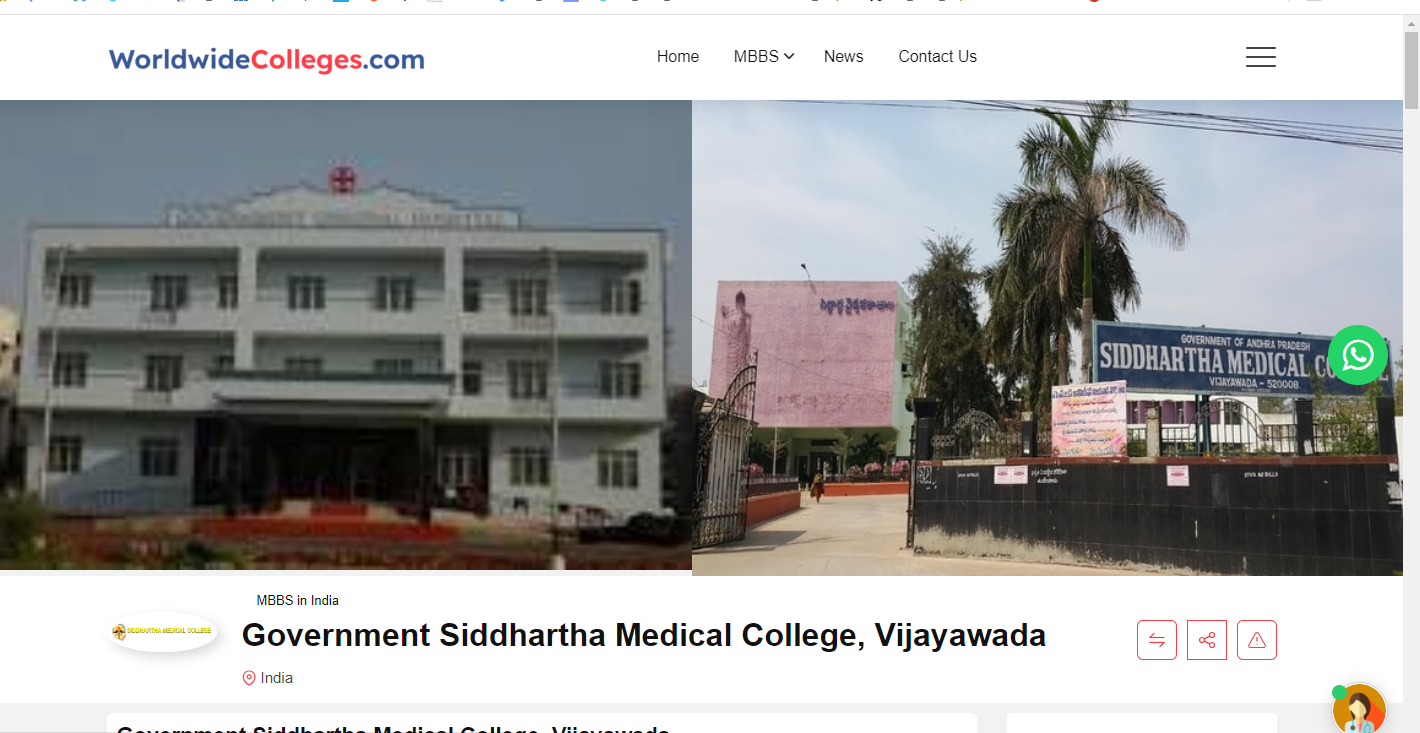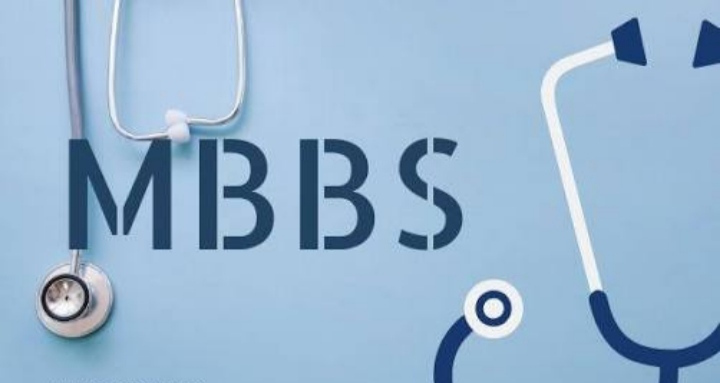
Government Siddhartha Medical College, Vijaywada
Siddhartha Medical College was established by Siddhartha Academy of General and Technical Education, Vijayawada -10 in November, 1980 with an annual intake of 100 students. As this is a statewide college admissions will be done following six point formula. The then Hon'ble Chief Minister of Andhra Pradesh late Sri.T.Anjaiah inaugurated the college on 13-3 1981.and the regular session started from 16- 3 – 1981.
A building complex for Siddhartha Medical College was completed in November 1985 with a floor space of 1,48,000Sq. ft. in an area of 57 acres and the college was shifted into this new premises on 7-11-1985.
The A.P. University of Health Sciences was established on 1-11-1986 in Vijayawada by the Government of Andhra Pradesh.. Siddhartha Medical College was handed over by the Siddhartha Academy of General & Technical Education to the A.P.University of Health Sciences on 21st December, 1986. The Government of Andhra Pradesh has de-linked the college from NTR University of Health Sciences on 21st December 2000 , and brought this college under the administrative control of Director of Medical Education.
Diploma in Radio-Diagnosis
सरकारी सिद्धार्थ मेडिकल कॉलेज, विजयवाडा
A Diploma in Radio-Diagnosis is a specialized program designed to provide education and training in the field of diagnostic radiology. Diagnostic radiology involves the use of medical imaging technologies to visualize and diagnose diseases and conditions. This diploma is typically geared toward healthcare professionals, such as radiographers or medical imaging technologists, who specialize in conducting and interpreting diagnostic imaging studies.
Here are some common components of a Diploma in Radio-Diagnosis program:
Radiographic Imaging Techniques: Training in the use of various imaging modalities, such as X-rays, computed tomography (CT), magnetic resonance imaging (MRI), ultrasound, and nuclear medicine.
Radiation Physics: Understanding the principles of radiation and its interaction with the human body in the context of diagnostic imaging.
Anatomy and Physiology: In-depth knowledge of human anatomy and physiology to facilitate the interpretation of medical images.
Radiographic Positioning and Techniques: Practical skills in positioning patients and operating imaging equipment to obtain high-quality diagnostic images.
Patient Care in Radiology: Communication skills, patient assessment, and care during diagnostic imaging procedures.
Radiation Safety and Protection: Practices to ensure the safety of patients, healthcare professionals, and the public during diagnostic imaging.
Contrast Media Studies: Training in the administration and interpretation of contrast agents for enhanced imaging studies.
Medical Imaging Equipment Maintenance: Basic understanding of the maintenance and quality control of diagnostic imaging equipment.
Ethics and Legal Considerations: Understanding ethical and legal aspects related to the practice of diagnostic radiology.
Clinical Internship/Practicum: Hands-on training in a clinical setting under supervision, where students can apply their knowledge and skills in real patient scenarios.
Upon completion of the program, individuals with a Diploma in Radio-Diagnosis are typically prepared to work as radiographers or diagnostic medical imaging technologists in hospitals, clinics, imaging centers, and other healthcare settings. They play a crucial role in the diagnostic process by producing high-quality images that aid healthcare providers in diagnosing and treating various medical conditions.
As with any educational program, it's important to ensure that the institution offering the diploma is accredited by relevant accrediting bodies or organizations in your region. Additionally, some individuals may choose to pursue further education, such as a Bachelor's or Master's degree, for career advancement or specialization in specific areas of diagnostic radiology
M.B.B.S.

Bachelor of Medicine, Bachelor of Surgery (Latin: Medicinae Baccalaureus, Baccalaureus Chirurgiae; abbreviated in many ways, most commonly MBBS, but also MB ChB, BMBS, MB BCh, MB BChir), is the primary medical degree awarded by medical schools in countries that follow the tradition of the United Kingdom. The historical degree nomenclature states that they are two separate undergraduate degrees. In practice, however, they are usually combined as one and conferred together, and may also be awarded at graduate-level medical schools.
Bachelor of Medicine and Bachelor of Surgery (MBBS), is a professional degree in medical science. A person holding the MBBS degree becomes a certified medical practitioner. The duration of MBBS course is five years and six months including one year of rotational internship at hospitals, health centres, and health camps organised by non-profit organisations (NGOs). MBBS course syllabus includes studies on anatomy, pharmacology, pathology as well as community health & medicine, paediatrics, and surgery. The syllabus, prescribed in such a way that MBBS degree holders can choose a specialisation for further majoring and practising medicine. The career specialisations for MBBS students are Nephrology, Cardiology, Gynecology, Anesthesiology, Organ Transplant, Endocrine, and General Surgery, etc.
MD - Anaesthesiology
The purpose of PG education is to create specialists who would provide high quality health care and advance the cause of science through research & training. A post graduate specialist having undergone the required training in anesthesiology should be able to recognize the health needs of the community. He or she should be competent to handle effectively medical problems and should be aware of the recent advances pertaining to his/her specialty. She/he should be highly competent anesthesiologist with broad range of skills that will enable him/her to practice anesthesiology independently. The PG student should also acquire the basic skills in teaching of medical/para-medical students. She/he is also expected to know the principles of research methodology and modes of consulting library. She/he should attend conferences, workshops and CMEs regularly to upgrade his/her knowledge. The purpose of this document is to provide teachers and learners illustrative guidelines to achieve defined outcomes through learning and assessment. This document was prepared by various subject-content specialists. The Reconciliation Board of the Academic Committee has attempted to render uniformity without compromise to purpose and content of the document. Compromise in purity of syntax has been made in order to preserve the purpose and content. This has necessitated retention of “domains of learning” under the heading “competencies”
MD - Bio-Chemistry
MD - Dermatology , Venereology & Leprosy
MD - General Medicine
MD - Microbiology
MD - Pathology
MD - Pharmacology
MD - Physiology
MD - Social & Preventive Medicine / Community Medicine
MD - Tuberculosis & Respiratory Diseases / Pulmonary Medicine
MD/MS - Anatomy
MD/MS - Obstetrics & Gynaecology
MS - General Surgery
MS - Orthopaedics
- Log in to post comments
- 49 views
